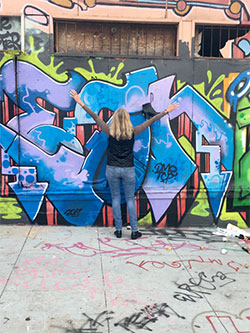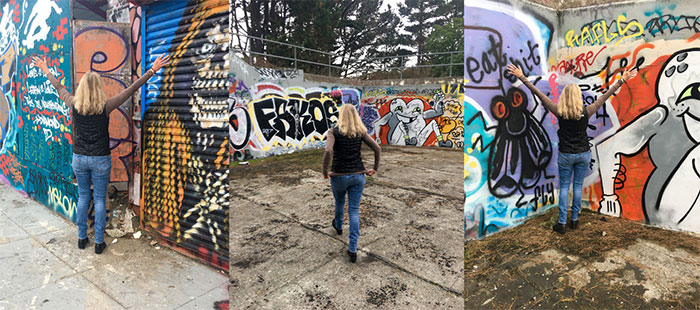What sane person could live in this world and not be crazy?
– Ursula K. Le Guin
My first foray as a graffiti artist occurred as a young child when left alone to inhabit my day and invent a more thrilling night. While the English wallpaper in the upstairs hall of our house in the Canadian countryside exuded elegance, the repetitious strawberry pattern lacked any juice at all. The dull shade of red for the berries needed to glisten, the green leaves longed for texture, the cream spaces to open up. I couldn’t bear one more predictable diamond shape around each cluster. So with a minimal palette of crayons, I set to work.
Everyone has to scratch on walls somewhere or they go crazy.
― Michael Ondaatje
While I’m conjuring north of the border stories in these turbulent times, I’m inspired (as always) by the work of Canadian – Sri Lankan writer Michael Ondaatje. His novel In the Skin of a Lion (1987) spotlights the labor contributions of the settlers who lived and loved on the fringes of the mainstream but never became part of Toronto’s official history. An exposé of the migrant condition in the early 1900s, “It is a novel about the wearing and the removal of masks; the shedding of skin, the transformations and translations of identity.”
Imagine a world where cultures co-exist in harmony, invigorated by their humanity. A planet of prosperity fueled by sustainable energy – where an unfettered press investigates with freedom. A land that honors civil rights, women’s rights, LGBT rights – not a kingdom of the far right, alt-right, and the faux righteous. A world with no nukes, no narcs or narcissists – where walls dissolve into art.
Imagine a city where graffiti wasn’t illegal, a city where everybody could draw whatever they liked. Where every street was awash with a million colours and little phrases. Where standing at a bus stop was never boring. A city that felt like a party where everyone was invited, not just the estate agents and barons of big business. Imagine a city like that and stop leaning against the wall – it’s wet.
– Banksy
Those who pounce to denounce scribbling, painting, scratching and marking walls or other surfaces as vandalism, or exclusively the work of gangs, might consider graffiti’s long moral history. From words and symbols, to cave drawings and elaborate wall paintings, this spontaneous form of expression dates back to Ancient Egypt, Ancient Greece and the Roman Empire. Now the offshoots of contemporary graffiti not only adorn, but inform. In addition to tagging, the throw up or bombing, a blockbuster or roller, stickers or wildstyle, projection artists aim to shine light on injustice and other thorny issues. In minutes, large-scale light projections transform outdoor space into a temporary venue for dissent and activism. In case you find this method of protest too illicit, did you know the Yale graduate program teaches light projection for this purpose? Depending on the size of the building, you simply need a van, a projector and a power source to illuminate your message. You’re in – you’re out. You’ve made an impact.
Yes, photography saved my life. Every time I go through something scary, traumatic, I survive by taking pictures.
– Nan Goldin
Making breaking news, celebrated photographer Nan Goldin, whose explicit and personal work bears witness to the shadows of the marginalized, is taking on the narcs – or rather the philanthropists who’ve donated millions to the Metropolitan Museum, the Guggenheim, the Victoria & Albert Museum in London, the Louvre, and Harvard, as well as other art institutions. Drug free for one year, after a near fatal finale stemming from a prescription painkiller for a wrist injury, Goldin re-focuses her lens. Using her strung-out self-portraits and images of crushed pills, she holds a prominent family accountable – the dynasty who’ve made their fortune manufacturing, aggressively marketing and misrepresenting OxyContin to doctors. Goldin urges museums to reject their donations and with her advocacy group P.A.I.N. seeks attention with a petition on change.org, “demanding the family fund rehabilitation centers, relapse prevention and holistic approaches; advertise the dangers of opioids; and re-educate doctors to stop overprescribing.” Artist takes on the opioid epidemic!
When I began this ode to dissent and self-expression by scribbling with my crayons, I confess to feeling my way. That’s always how it works. I’m struck by the graffiti I encounter in the bay area with my son – but equally fascinated by his portraits examining me examining the art. I veer off on a side trip to my Canadian roots, bump into the elusive Banksy, and then like a voyeur plunge into Nan Goldin’s dark and intimate images. Along the path of creation, I hear of the death of poet and novelist Ursula Le Guin at age 88, in Portland, Oregon. So I take time out to honor her legacy and vision. Translated into 40 languages, Le Guin wrote more than 20 novels and elevated sci-fi to a literary form creating imaginary worlds of politics, the environment, gender, sexuality and religion. She penned 12 books of poetry, 100 short stories, 7 collections of essays, 13 children’s books and 5 translations, including the Tao Te Ching of Lao Tzu and selected poems by the Chilean Nobel Prize winner Gabriela Mistral. And I will always hear the echo of her mantra.
It is good to have an end to journey toward, but it is the journey that matters in the end.
– Ursula K. Le Guin
So in spite of the consequences of my childhood graffiti experiment, I do not regret disrupting the pattern of static strawberries. I only put them in the wild to set them free! And I hope in your travels you will round a corner and discover unexpected graffiti or an enlightened exposé to startle your complacency. And beams of light from no-where to illuminate your thoughts.



I don't know why, but graffiti has never been an art form that intrigued me. Until now. In reading your blog I have a new-found appreciation for wall scratching, and think it would be interesting to plan an entire trip around seeing the variety of such art throughout a couple continents. I have always loved the "street painters" of Europe, who transform cobblestone streets into something so magnificent you don't dare step foot over it. And then the rains come and dissolve all that attention to detail and color and form; erasing the history and the story. Thank you, Martha, for awakening my curiosity and for introducing me to Le Guin.
I consider graffiti folk art and like Bansky, wish it were legal. Thank you Martha. Xo jane
A first reading a month ago, then distracted by more genuine chaos and murder of our young, now some relative calm to reread your blog. Thank you for your so thorough analysis changing at least a little my feelings about graffiti. It is good to be reminded of the sidewalk chalk drawings of Europe and to learn of the Yale graduate program of projecting a message on the side of a building. Inspiration from early Batman comics with the Batsymble projected on the clouds above Gotham?